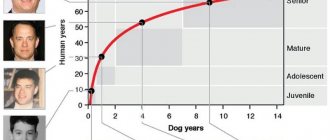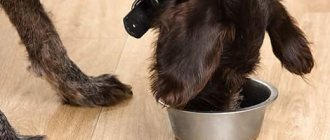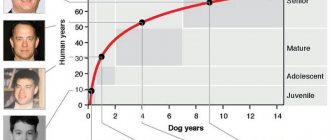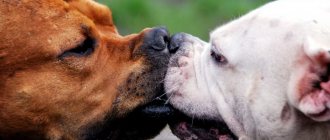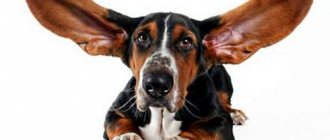Man has long tamed cats and dogs. Some pets live with us for quite a long time, others leave very quickly. Is it possible to extend the life of the furry members of our families and how to do it?
The lifespan of cats and dogs is influenced by various factors. The most important of them are the organization of nutrition and physical activity. During each life period, animals require a certain diet and activity level. To do this, you need not only to know exactly how old the cat or dog is, but also to understand how the pet’s age compares to human age.
In cats, life stages are conventionally distinguished:
1. Kitten: 0-6 months The period when a young cat grows rapidly, develops and barely reaches sexual maturity.
2. Young cat: 6 months - 2 years The cat reaches its full adult size, learning about life and survival.
3. Cat in its prime: 2 years - 6 years The cat is fully developed physically and intellectually, she is healthy and very active, her coat looks smooth and shiny.
4. Mature cat: 7-10 years A cat is called mature when, by human standards, it can be given from 40 to 50 years.
5. Older cat: 11-14 years old The cat is about 70 human years old.
6. Older Cat: 15 Years and Up Many cats reach this stage without showing any signs of aging! Although the age of these cats by human standards is more than 70 years.
This is interesting: How to calculate the age of a cat
By weight
Be sure to pay attention to your pet's weight! Over the years, the animal’s daily routine changes, which is why the body weight of cats of different ages is different.
Kittens move a lot, their skeleton is not yet fully formed and strong, and the fat layer is almost not deposited. This is why babies and young pets weigh quite little.
Important! Monitor your pet's diet. A poor diet or lack of adequate exercise can lead to unhealthy weight gain!
Adults, and especially older pets, are already reluctant to agree to conquer the heights of a home closet or excitingly climb expensive curtains. They tend not to play as much and prefer to take more naps. A sedentary lifestyle leads to weight gain.
Ratio table
Like people, animals go through several stages of growing up: childhood, puberty, maturity and old age. It is necessary to take into account the rate of change at a particular stage in order to find out how old a cat is by human standards. The table below details the pet's maturation:
| Life stage | Cat age | Human equivalent |
| Kitten (birth – 6 months) | 0-1 month | 0-1 year |
| 2 months | 2 years | |
| 3 months | 4 years | |
| 4 months | 6 years | |
| 5 months | 8 years | |
| 6 months | 10 years | |
| Adolescent/young (7 months – 2 years) | 7 months | 12 years |
| 12 months | 15 years | |
| 18 months | 21 g | |
| 2 g | 24 g | |
| Adult (3-6 years old) | 3 g | 28 years |
| 4 g | 32 g | |
| 5 years | 36 years | |
| 6 years | 40 years | |
| Mature (7-10 years old) | 7 years | 44 g |
| 8 years | 48 years old | |
| 9 years | 52 g | |
| 10 years | 56 years old | |
| Elderly (11-14 years old) | 11 years | 60 years |
| 12 years | 64 g | |
| 13 years | 68 years old | |
| 14 years | 72 g | |
| Very old (15 years and older) | 15 years | 76 years old |
| 16 years | 80 years old | |
| 17 years | 84 g | |
| 18 years | 88 years old | |
| 19 years | 92 g | |
| 20 years | 96 years old | |
| 21 g | 100 years | |
| 22 g | 104 g | |
| 23 g | 108 years old | |
| 24 g | 112 years | |
| 25 years | 116 years |
The calculation starts at a rate of 1 in 12, peaking at one year of age (1:15) and gradually falling to a ratio of approximately 1:4.6. It shows that the pet is a dynamic variable.
It is necessary to build on current figures in order to understand and determine how old the cat is by human standards. The table describes in detail the interspecific proportions.
Determining age by external signs
Animals are not always adopted by owners in infancy. If a person has an adult cat, an examination will help determine its age:
- Body. An animal that has survived several years on the street has dense muscles. Brownness is a sign of most homeless individuals. But the young cat has soft muscles. Years of fighting for territory form a densely built body with a minimum fat content, accumulating, if possible, in preparation for winter. In older individuals, sagging skin on the abdomen (under the arms) and protruding shoulder blades are observed.
- Teeth. A white, healthy jaw is a sign of an individual aged 1-2 years. Of course, kittens can also have dental problems. But it is possible to distinguish inflammation caused by poor nutrition from plaque that has formed over the years. The latter may not cause discomfort, but will stain the enamel dark.
- Wool. Helps to determine by touch the age of a cat by human standards. The table indicates that the pet lives more than 100 years, when translated into the owner's chronology. The older the individual, the tougher its pile. Older animals may also experience gray hair and localized baldness.
- Eyes. In young people - clear, without signs of tears or mucous discharge in the corners. Although their appearance is also facilitated by pathogens and weakened immunity. The texture of the iris is one of the ways to determine the age of a cat by human standards. In young individuals it is relatively uniform - with the exception of pigment spots or traces of injury. With age, the vessels of the organ appear. Lacrimal tracks are also formed, into which secretions caused by injuries, infections and inflammatory processes flow.
People communicate not only with pets, which they raise from infancy. Having realized that a 7-year-old cat by human standards is equal to 44 years old, they can begin to have great respect for their dacha “neighbor” who has survived another winter. Understanding the relationships will also help in communicating with your own pet.
Why know your pet's age in human equivalent?
Life expectancy depends on conditions. So, the tramp will be lucky to celebrate 9 years - the cat, by human standards from the table, will turn 52 years old. In human terms, he will not even cross retirement age. On the street, an individual risks not living to see its 5th anniversary due to: transport;
- clashes with relatives and other animals;
- poor quality nutrition;
- atmospheric phenomena.
The home offers the pet a comfortable environment. But the owner should also recalculate the cat’s age in human years. When an animal enters the elderly phase, it becomes more susceptible to:
- cancer;
- diabetes;
- cardiovascular diseases;
- problems with kidneys and other organs.
The root causes of illness are poor diet, infections, injuries or contact with pathogens, such as fungus in the bathroom. But age additionally increases the likelihood of developing diseases due to weakened immunity.
As in the case of a person celebrating his 60th birthday, an animal older than 8-10 years needs attention to its health.
If castration (sterilization) has not been performed, the individual should be checked regularly (at least once a year) for signs of genital cancer. Regular examinations are also necessary in the presence of chronic diseases.
If at 6-7 years old a pet with kidney failure had enough proper nutrition, then after the 10th anniversary it is better to periodically (1-2 times a year, in the absence of signs of inflammation) give urine for analysis. For problems with the heart and other organs, regular checks are also advisable.
You should refrain from preventive visits to the veterinarian if your pet is nervous. If an elderly individual does not show signs of illness (weakness, anxiety, refusal to eat, etc.), there is no need to expose her to unnecessary stress.
Like any animal, a cat goes through several stages of development. These stages must be taken into account when comparing a pet's age to a human's. An individual grows fastest during the period of up to 6 months. Then the speed slows down gradually, reaching a ratio of 1 cat year to 4.5-5 human years.
Knowing the proportion will help calculate the age of the animal at a specific point in time and adjust its care at different stages of development.
The table also makes you think about the pet’s quality of life. So, if we start from the “dog” variable, a 15-year-old cat corresponds to a 105-year-old person (82.5 years, if we take a multiplier of 5.5). Respectable age.
But a dynamic calculation shows that such an individual dies at 76 years of age. Not much compared to a person who has access to quality food and health care. By monitoring the health of the pet, owners can ensure its “centenary” anniversary.
Features of the development of dogs in comparison with humans
Dogs grow up differently. If we compare the stages of development of dogs and humans, we get the following picture:
- 0–1 month. By the age of one month, the puppy begins to actively explore the surrounding space. In this, he resembles a one-year-old child who is trying out many things. Such a baby knows no fear, and he needs care and constant supervision.
- 1–4 months. By the age of four months, an inquisitive puppy begins to be trained at the training ground. He begins to change teeth, like seven-year-old children, and he is just as careless and playful.
- 4–6 months. A dog at 6 months of age who is entering puberty can be compared to a 14-year-old teenager. The puppy's body grows unevenly, he has a childish perception of the world around him, and the dog's mood often changes.
- 6 months – 1 year. The age of 12 months for a dog corresponds to 16–18 years for a person. At this time the dog stops growing. She becomes more self-confident, males strive to establish leadership between their fellow tribesmen.
- 1–2 years. A two-year-old dog reaches the peak of its physical development, like a twenty-year-old person. Bitches at this time are already ready for motherhood. The dogs have already been trained in all commands.
- After five years. From this age, the dog begins to slowly age, like a forty-year-old person. The animal becomes more restrained and calm, it already has all the skills and knowledge for everyday life.
- 8 or more years. Dogs are entering their retirement period, that is, their bodies begin to age quickly. Similar changes occur in people aged 60–70 years. Dogs need to be given a more balanced diet and limited exercise.
Simple Arithmetic
A very simple way to find out how old a cat lives by human standards is to multiply the animal's age by 7. This method gives the most inaccurate result of all those listed above, for example, a one-year-old cat is more independent than a child aged 7 years . The reason is that our pets are driven mainly by instincts, which help them adapt faster. Also, cats more often live to be 20 years old than humans are to live to be 140. This arithmetic method, in which the year of a cat’s life by human standards is equal to 7 years, does not make it possible to compare the stages of development of intelligence.
Converting a cat's age to human age using the proposed systems is not difficult. The main problem is that none of the existing methods will give an accurate result.
What types of teeth do dogs have?
Incisors
When viewed from the center of the jaw, the incisors are six teeth, growing three to the right and left (the upper ones are much larger than the lower ones, a total of 12 on each jaw). They help the animal bite off food. The central pair of incisors are called “hooks”, followed by the middle incisors and edges. The crown of all incisors is wedge-shaped, and the cutting surface seems to be divided into three lobes (trefoil)
Fangs
It is difficult to confuse them: 4 sharp fangs are an attacker’s worst nightmare. The crown has a conical, forward-curved shape, specially adapted for tearing prey. We must not forget that even the cutest baby is a ferocious predator at heart.
Chewing teeth (molars and premolars)
The teeth located from the canine to the beginning of the jaw belong to the chewing group. 4 premolars (false roots), 3 molars (molars) on each side on the lower jaw, and 4 premolars, 2 molars on the upper jaw. For ease of clamping and grinding food, their surface is equipped with tubercles.
The method of estimating the age of an animal by teeth is based on general patterns in the schedule of their eruption, replacement and wear.
Age comparison principles
There is an opinion that in order to calculate the age of a cat by human standards, it is enough to multiply it by seven. In fact, this approach is only valid for animals between three and ten years of age.
They grow up and grow old at a completely different pace than humans.
It is necessary to take into account the principles of recalculation:
- There is no calculation formula for cats under three years of age.
- A three-year-old animal reaches approximately the same degree of development as a person at 25-30 years old.
- From three to five years, this figure increases by 7 every year.
- From five to twelve years – by 4.
- After twelve years, each year is counted as 3.
Indication of age in documents
By purchasing a purebred puppy, the owner receives a pedigree registered with a canine organization with information about ancestors, indicating the date of birth, nickname, brand or chip. There must be reports on the mating of breeding dogs and on the examination of the baby.
In the veterinary passport, the doctor enters information about the animal’s date of birth, the owner’s contact information and notes on the preventive measures taken.
How to find out more accurately
It is possible to calculate the age of a cat, more precisely by human standards, using tables. There are a couple of consolidated ones that specify the age ratio of a person and a cat, first for a period of up to 1 year, and then after the pet reaches puberty. For the convenience of considering and converting cat years into human years, this information is combined into one common table.
| Animal lifespan | Human years | Animal lifespan | Human years |
| 1 month | 5-7 months | 7 | 54 |
| 2 months | 10-11 months | 8 | 57 |
| 3 months | 2 | 9 | 60 |
| 4 months | 5-6 | 10 | 63 |
| 5 months | 9-10 | 11 | 66 |
| 6 months | 13-14 | 12 | 69 |
| 7 months | 15 | 13 | 72 |
| 8 months | 16 | 14 | 75 |
| 1 | 24 | 15 | 78 |
| 2 | 36 | 16 | 81 |
| 3 | 42 | 17 | 85 |
| 4 | 45 | 18 | 87 |
| 5 | 48 | 19 | 90 |
| 6 | 51 | 20 | 93 |
This is interesting: Life expectancy of cats
Long-lived cats
Famous cats and cats - record holders for life expectancy:
- Lucy the cat – 39 years old (born in 1972, the record was registered during the cat’s lifetime in 2011), South Wales, UK
- Cat Cream Puff – 38 years old (1967-2005), Texas, USA
- Baby Cat – 37 years old (1970-2007), Minnesota, USA
- Cat Granpa Rex Allen - 34 years old (1964-1998), Texas, USA
- Scooter the Cat – 30 years old (1986-2016), Texas, USA
In the photo, the long-lived cat Cream Puff
There is no relationship between the breed of a cat and its lifespan. Representatives of indigenous breeds (Norwegian Forest, Siberian, Maine Coon) were distinguished by good health and longevity until they were affected by mass artificial breeding.
How many years do domestic cats live?
A domestic cat lives on average 15-17 years, however, 18-20 year old cat grandparents are also not uncommon these days. The longest living cats are those that live in a house without free-roaming and are well cared for. The life of homeless cats, whose life is full of hardships and dangers, is short - about 5-6 years. The fate of pets who end up on the street from home and are not adapted to independent living is an unenviable fate - they most often die within the first 1-2 years.
The lifespan of each cat is individual and largely depends on genetic predisposition. It is believed that breed does not affect life span, but this is not true. Unfortunately, to improve breed qualities, most breeders resort to closely related crossing of animals (inbreeding), which not only perpetuates the “ideal” appearance, but also unfavorable mutations. As a result, diseases that were rare 20-30 years ago have become commonplace today. Among them are hypertrophic cardiomyopathy, chronic renal failure at a young age, allergies and autoimmune pathologies.
By behavior
It is possible to determine the age of a pet by its behavior. This method is quite subjective and depends on the character of the animal, but there are still common features in habits.
Baby kittens spend almost all their free time playing and communicating with each other and people. They are even ready to courageously sacrifice minutes of sleep for the sake of fun! Some kids even insistently demand attention to themselves.
Important! You should not be strict with your pet's behavior. Animals also have different types of personalities, so some cats are sociable, while others are shy.
Mature pets will enjoy spending time hunting and playing. However, they tend to be very sleepy.
Older cats no longer like unnecessary fuss, preferring quiet rest to noisy games. Pets can often be found dozing peacefully on a chair or on your bed. As cats age, their hearing often becomes dull and their vision begins to decline, which can cause the animal to become a little more fearful or nervous.
Methods for converting a cat's age to human age
There are three main ways to convert a cat's age to human age. As zoologists admit, none of them is completely accurate.
Method No. 1
One year is taken as the starting point - the period of puberty of the kitten. This age corresponds to 16 human years.
The second milestone is two years, when character and behavior are finally formed. It can be considered 24 years by our standards.
After three years, age is calculated on a calculator using the formula:
x = 24 + (cat's age – 2) * 4
Method No. 2
The second method has its own formula for each of the three segments of life:
| Cat age (z), years | Formula |
| 1-5 | x = z * 7 |
| 6-11 | x = (z – 5) * 4 + 35 |
| 12-20 | x = (z – 11) * 3 + 59 |
Method No. 3
This technique was developed by zoologists and veterinarians. The basis is a coefficient that takes into account not only the physiological development, but also the psychological and intellectual level of the animal at each stage of life.
On this basis, a table has been compiled that allows you to approximately find out the relationship between the age of a cat and human ideas.
Kittens up to one year:
| Animal age (months) | Similar human age (years) |
| 1 | 0,5 |
| 2 | 1 |
| 3 | 2 |
| 4 | 6 |
| 5 | 10 |
| 6 | 13 |
| 12 | 18 |
Adult cats and female cats:
| Animal age (years) | Similar human age (years) |
| 2 | 25 |
| 3 | 32 |
| 4 | 35 |
| 5 | 40 |
| 6 | 43 |
| 7 | 46 |
| 8 | 50 |
| 9 | 55 |
| 10 | 60 |
| 11 | 64 |
| 12 | 67 |
| 13 | 70 |
| 14 | 72 |
| 15 | 75 |
| 16 | 76 |
| 17 | 78 |
| 18 | 83 |
| 19 | 91 |
| 20 | 100 |
Although this definition is closest to the truth, it must be remembered that it is impossible to accurately compare human and cat ages due to their fundamental differences in development as biological species.
By body processes
Perhaps determining age by the internal processes of the body is the most accurate way. Using this watch it is easy to find out how old your pet is.
Puberty in cats begins at 7-9 months (sometimes earlier, at 6 months), but in boys a little later - at 9-11 months. Slight differences may occur due to climate, breed and weight of the animal.
Determining the age of your pet is incredibly important. This is the only way to create the correct diet, daily routine and the amount of vitamins you need.
What is the average life expectancy of cats?
In the wild, animals live a maximum of 5–7 years.
At home, life expectancy is significantly longer and averages from 13 to 18 years. True, there are also centenarians who are happy to celebrate their 20th anniversary.
Stages of life
The life of a pet goes through several stages:
- childhood . Ends at six months of age;
- youth _ The period lasts from six months to two years. Puberty occurs and changes in behavior are noted. Already at the age of one and a half years, a cat can give birth;
- youth . The stage lasts from two to five years. The blossoming of strength is noted. The pet is active and full of energy;
- maturity _ Lasts until the age of ten. The pet continues to remain active, but reacts more calmly to everything that surrounds it;
- pension and old age . Occurs between 11 and 15 years of age. The animal already requires special care. He is calm, less active. There is a deterioration in the condition of the coat.
Visual inspection
This method of assessment is used if it is not possible to conduct a full examination of the animal or when encountering an aggressive, presumably stray, dog. The correct determination of age will allow you to build the correct behavior with the dog, which will differ for a young puppy expressing a desire to play or with an elderly dog who may have undergone mental changes.
When visually assessing, attention is paid to the following features:
- Muscle tone. A young dog has an elastic, strong, lean body, the muscles are not yet developed, the chest is narrow. The adult individual is noticeably different; it has an expanded chest, bonyness, which is clearly visible in the ridge area, or is overweight due to a sedentary lifestyle; gray hair may also be noted on the face.
- Activity. If the movements are energetic, then the dog is young. Difficulty moving is characteristic of old age.
- The fur of a young individual is thinner and softer, while that of an adult is often thick and coarse.
- The eyes of young animals are clear and bright; with age they become dull and cloudy.
Periods of a pet's life
The life cycle of a cat, by analogy with a person, is divided into several stages. An animal is born, grows up, matures, and then becomes old and dies. At the same time, yard cats usually live shorter lives, but domestic cats can reach a very old age. Each period is characterized by its own characteristics, which affect not only the physiological, but also the psychological aspect.
Childhood
Lasts from 2 to 6 months. Since kittens develop very quickly at this age, it is quite difficult to determine how old they are by human standards. Thus, three-month-old babies can be identified with two-year-old children, but by six months the age limit rises to 14 years.
Related article: What should an owner do if a cat is obese?
As a rule, a small kitten is very active, playful, inquisitive and sociable. From his mother he learns vital skills and also learns independence. These few months, until the baby moves on to the next stage of life, are best devoted to his upbringing.
Youth
Lasts from 7 to 12 months, but sometimes lasts up to two years. Young cats no longer develop as quickly as kittens, and by the age of one year they become fully sexually mature. The animal's breed characteristics are finally formed, a life rhythm is established, and certain habits appear.
This stage for animals is comparable to the teenage, transitional period in humans. This is no longer a child, but not yet an adult cat, and therefore it is impossible to treat it condescendingly or encourage permissiveness. It is worth remembering that habits formed in youth will remain with your pet for the rest of its life.
Youth
Lasts from 2 to 6 years. The most productive period that can be identified with human years is 20-35. Young cats are at the peak of their activity, full of strength and vitality. As a rule, at this stage, pets participate in competitions or exhibitions, and also give birth to strong, healthy offspring.
Maturity
Lasts from 7 to 10 years. Comparable to humans, the age of a mature cat ranges between 40 and 55 years. The pet settles down, becomes calmer, and the activity characteristic of youth decreases somewhat. Despite still being in good health, animals are no longer taken to competitions, and they also stop breeding them.
Old age
Starts at age 11. It is during this period that cats need increased attention and care. Elderly pets often lead a passive lifestyle, sleep a lot, and are more often susceptible to various diseases. To prolong a cat's old age, the owner needs to provide the most comfortable maintenance for his pet.
With proper care and regular visits to the veterinarian, cats can easily exceed the 15-year mark.
( 1 rating, average 4 out of 5 )
Method number 2. According to muscle condition
There is another way to approximately determine the age of a dog as a result of an external examination. This is the feeling of the animal's muscles.
- If you feel elastic, strong muscles under your hands, then the pet is young. Like a person, he is full of strength and energy. Most likely, he will be constantly on the move, and he will not need much time to rest.
- If you feel flabby muscles or even signs of obesity when palpating, then most likely this is an elderly animal. Here we must make a digression and say that a dog is considered elderly from the 8th-9th year of life (if translated into human years, this is approximately more than 60 years). Such an animal will sleep more than be active. Calluses may be felt on the bends of the joints. The stomach drops.
How to determine the age of a cat by external signs
It is extremely difficult to determine the age of an adult cat by its appearance. Often animals of very advanced age do not look decrepit and weak. If the age of the new pet is unknown, you can try to find it out using the following parameters:
- Teeth. The only reliable criterion for determining age is the appearance and change of teeth - useful only for kittens. At 2-3 weeks, babies develop incisors, at 3-4 - canines, at 3-6 - premolars. Then, at 3-4 months, the incisors change, and at 4-6 months, the remaining teeth. By 7 months, the change of teeth is completed. After 1-1.5 years, a yellowish coating appears on the surface of the teeth, which becomes more intense over the years. Age-related tooth loss is an individual factor: some 16-year-old cats can boast a fully “complete” toothy mouth, and in some, dental diseases accompanied by tooth loss occur as early as one year of age.
- Wool. Until old age, healthy cats have a smooth and shiny coat and a dense undercoat. Then the undercoat thins out and the coat becomes less smooth. In long-haired animals in old age, a decrease in the volume of the tail due to wool is clearly noticeable. After 8-10 years, individual gray hairs may appear (total graying, as in humans, does not occur in cats). In old people, the fur becomes dull, the mustache thins and shortens.
- To the eyes. Up to 1-2 years, cats will retain “kitten” curiosity and enthusiasm in their eyes, even during rest. Older individuals look at the world more calmly and lazily. After 10-12 years, the eyes begin to gradually “sink”, but their clarity remains until old age, if the pet is healthy.
- Conditions. The body of young cats feels soft and plastic, and after 5 years it becomes denser, as if “hardening” (which does not in any way affect their dexterity). After 8-10 years, the contours of the cheeks, chin and body become less rounded. In old age, the muscular system and fat layer undergo dystrophic changes, the animal loses weight and “shrinks out.”
- Musculoskeletal system. The condition of the musculoskeletal system in cats changes little over the years, so gait practically does not change with age, and the ability to jump high remains in old age. Joint stiffness with a noticeable decrease in physical activity is typical in old age
A veterinarian can more accurately determine the age of a cat by examining the fundus of the eye or by the condition of the internal organs during surgery.
They don’t ask about age, but look at the dog’s teeth
The most accurate idea of the age of a four-legged homeless person will be given by a comprehensive assessment of the condition of the teeth, eyes and general condition. It’s easy to understand offhand who is in front of you: a very young puppy, an angular teenager or an adult animal. Then the difficulties begin. The first thing an experienced dog owner will do is look carefully into the toothy mouth. But to do this, you need to know exactly where to look and what to evaluate.
Show your teeth: anatomy
Canids are classified as heterodont animals. Their teeth differ in structure and perform different functions. Adult quadrupeds have 42 permanent teeth (20 at the top and 22 at the bottom), and puppies sport 28 baby teeth (14 on each jaw). Knowing the atomic structure of a dog's jaw will greatly help during examination.
Does an animal's lifestyle matter?
For cats to live happily ever after, they need to be given the most favorable conditions possible. These include:
- proper, balanced nutrition;
- cozy, warm house ;
- no injuries;
- periodic visits to the veterinarian;
- protection from external adverse factors.
If you are interested in detailed information about proper grooming, we recommend that you read the article
In addition, the following factors affect life expectancy in cats:
- heredity;
- presence/absence of genetic diseases.
It is worth noting that sterilized cats and castrated cats have a longer life expectancy than individuals participating in procreation.
We recommend an article on the importance of sterilizing cats
The absence of stress during the mating season has a positive effect on their condition.
Neutered cats live longer
Interesting! According to the observations of veterinarians, the life expectancy in most cases in cats is from 10 to 15 years.
Factors influencing the rate of aging and life expectancy
On average, dogs live 12.8 years, cats - 14 years. These are the average age of the record-breaking dog, the Australian cattle dog Bluey, 29 years old. Among cats, the record was set by the cat Lucy, who is currently 42 years old. Cats often live much longer than dogs.
The lifespan of a dog is greatly influenced by its size; small animals are given more time than large animals. Among giant breeds, the normal life expectancy is 10 years, while small indoor dogs can easily live up to 16.
Otherwise, the factors that influence how long your pet will live are common to dogs and cats.
Breed
Outbred animals - mestizos - are famous for their good health. They are more resistant to infections, since they are a product of not only artificial, but also natural selection and most often have small or medium sizes.
But even among purebred cats and dogs, some breeds guarantee a longer life on average, for example, Dalmatians often live longer than purebred dogs of the same size. Another simple rule is that breeds that are far from their wild ancestors and have undergone significant changes during the breeding process cannot boast of a large number of long-livers. Representatives of “natural” and old breeds live longer. This can be explained very simply - the smaller the number of individuals from which the breed is bred, the worse the health of the animals will be. And all breeds with an unusual appearance were bred from a very limited number of animals, without significant infusions of “fresh” blood. Until recently, old breeds (Siamese cats, various herding dogs) were formed in uncontrolled conditions, in which, along with human preferences, the breed was influenced by its ability to survive.
Therefore, if you are determined to buy a dog or cat with an elaborate, altered appearance, you should be prepared for the fact that your pet will leave you at a relatively young age.
Sex and participation in reproduction
Animals are characterized by the same dependence as people - bitches and cats live on average a year or two longer than males and cats. This is primarily due to the fact that males spend a lot of energy and health on conquering territory and are damaged in fights, which they engage in much more often than females.
Sex-dependent, life expectancy only exists if the animal is not spayed or neutered. Dogs and cats deprived of reproductive functions live an order of magnitude longer - they do not experience stress associated with sexual behavior. Therefore, if you want your pet to live a long time and do not plan to get offspring from it, the best option would be castration or sterilization.
This is interesting: Japanese Diet for 7 Days Menu Table
Lifestyle and living conditions
Just like people, animals that eat well, live in a warm home, get regular veterinary checks, and don't get injured while wandering the streets live longer than strays. The average life expectancy of stray cats is 6-8 years. For dogs, this rule is also true, so street dogs living in a kennel around the yard die at a younger age - they are constantly exposed to negative environmental factors.
It is difficult to compare the age of a pet with a human due to the numerous characteristics of the psyche and way of thinking of our pets. But comparison tables will help you imagine what emotional age level your pet is at, and factors influencing life expectancy can help prolong the happy life of your four-legged family member. It is always worth remembering that all dog and cat ages, including old age, have their advantages if the animal is healthy.
Long-lived dogs – TOP 5 breeds
There are several dog breeds that are distinguished by good health and long life expectancy.
- The New Guinea Singing Dog is an aboriginal breed with excellent health and strong innate immunity. The dog is notable for the fact that its average lifespan is from 19 to 20 years. Moreover, females are capable of producing full-fledged offspring up to 12-13 years of age.
- Chihuahua is a Mexican, representative of the smallest dogs. The advantage of a Chihuahua is good health and the absence of hereditary diseases, but in cold weather it is recommended to wear dog overalls for walks to avoid colds. The average life expectancy is 17 years, but with good care it lives 20-22 years.
- The toy poodle is a German decorative dog (height at the withers is 15 cm). One of the positive qualities of a living toy is its significant life expectancy, which is 17 years and above.
- The Jack Russell Terrier was bred in Great Britain as an excellent companion and hunter. He is very active and needs frequent walks and lots of exercise. The owner can enjoy companionship with his friend for 16-20 years.
- Cockapoo is an artificially bred cross between a miniature poodle and a cocker spaniel. Thanks to the efforts of breeders, the dog has a lot of advantages. Will stay with the owner for 17-20 years.
What dog breeds live the shortest?
Dogs of impressive size have the shortest life expectancy. It’s a shame that these smart and devoted friends can only stay with their loving owners for no more than 10 years.
- The Dogue de Bordeaux was developed in France. A very beautiful, confident and calm dog of large size, with strong bones. The average lifespan is short and is 6-8 years.
- The Great Dane is another representative of the giant breeds. This is a devoted, faithful and very smart friend. The breed is rightfully considered aristocratic, but does not live long - 7-8 years.
- The Bernese Mountain Dog was born in Switzerland. This is a representative of large herding dogs. Apartment housing and its companion – physical inactivity – have a very bad effect on the pet’s health and shorten years of life. On average, the Bernese Mountain Dog lives 8-10 years.
- The Irish Wolfhound is a large, wire-haired dog bred specifically for hunting wolves and other large game. Possesses fragile health and low life expectancy (6-8 years).
- The Neapolitan Mastiff is a large dog, fearless in battle with enemies, faithful and devoted to its owner. Even with good care, the Neapolitan Mastiff lives 6-8 years.
Why do small dogs live longer than big ones?
Biologist Cornelia Kraus from the University of Gettin, conducting research with large and small dogs, noticed the following pattern: the rate of aging of animals depends on the presence of growth hormones in their bodies, in particular the insulin-like growth factor IGF-1, produced by the liver. Cornelia suggested that large puppies contain more of it, because they grow in height more rapidly:
- a poodle puppy, when it reaches one year, becomes 20 times heavier;
- A Great Dane puppy becomes 100 times heavier after living for a year.
The biologist suggested that the rapid aging of large dogs is a side effect of the presence of this hormone in the body. Thus, dog years and the level of development in large and small pets are almost identical in the first years of life. The difference begins to increase rapidly after the fifth year of life.
Fairness of the matching rate
The correspondence coefficient presented in the table is also conditional to a certain extent. When converting a dog's age to a human one, A le Beau found that in the first years of life animals develop faster than at a more mature age; accordingly, at this time they live longer in a human year than in old age. To prove this, he compared:
- the moment of puberty;
- the onset of maturity (when the dog turns from a teenage puppy into an adult);
- life expectancy.
In the process of studying animals, the scientist did not take into account their size and breed, which led to errors that the researchers tried to explain using Kleiber's law.
According to him, large breeds of dogs should live longer, since the metabolic rate is related to the weight of the living organism. However, in reality this is far from the case. Small dogs (terriers, lapdogs, Pekingese) live longer than their larger counterparts. Presumably this is due to delayed cell death in small animals. The aging process slows down and the risk of developing diseases decreases.
Kids
Photo - how a dog's appearance changes with age
Dogs can change the owner’s quality of life for the better. The latter has the power to provide the pet with adequate care both during puppyhood and during natural aging.
3.7 / 5 ( 3 voices)
Youth
The table “The age of a cat by human standards” shows that a one-year-old animal can be compared to an 18-year-old person.
It is this age that corresponds to psychological and physical development. The cat seems already grown up and serious, but often behaves like a child, plays a lot, hides, etc. The cat has already grown to an adult size, has lost the childish fluffiness of its fur, its movements no longer seem funny and clumsy, grace and predation appear.
The speed of maturation also depends on the breed of cat. For example, oriental breeds form early and are fully developed within a year. But large breeds can reach maturity only at 1.5-2 years.
Rule "7 to 1"
Since the 1950s, a popular calculation of how old a dog was "in human years" has been that 1 dog year is the equivalent of 7 human years. Even though this formula has been around for a surprisingly long time, the reality isn't all that complicated. Kelly M. Cassidy, curator of the Charles R. Connor Museum at Washington State University, which collects research on longevity in dogs, says it's not entirely true that the seven-year rule is wrong. One explanation for how this formula came about is that the 7:1 ratio appears to be based on the statistic that humans once lived to about 70 years of age and dogs to about 10.
William Fortney, a veterinarian at Kansas State University, suggested to the Wall Street Journal that this calculation of a dog's age was simply a marketing ploy. In this way, veterinarians informed the public about how quickly dogs age compared to humans, mainly from a health point of view. This was a way to encourage owners to bring their pets in at least once a year for a general checkup.
Advances in medicine over the years have increased our life expectancy through improved diagnosis and treatment. Veterinary medicine has also made it possible for our pets to increase their life expectancy. When trying to figure out how old your pet is, the old school was 1 year in dog years equal to 7 years in human years. It looks like this kind of fuzzy scale is getting old. Our pets also reach maturity at a certain age, but because they have shorter lifespans, they age faster than us.
Calculating a pet's age gives an idea of what their chronological age is. Finding out a dog's age in human years helps to see them at their actual age as they get older. Using the old formula "1 dog year equals 7 human years" is simple and easy to remember, but does not provide an accurate calculation when comparing a pet's age to a human's. For example, a dog reaching its first birthday can already reproduce, but a 7-year-old child still has a long stage to go through before he reaches this opportunity.
We also recommend reading:
The largest dog breeds What is domestication in animal husbandry Why you should get a cat: reasons voiced by scientists Euthanasia of animals

